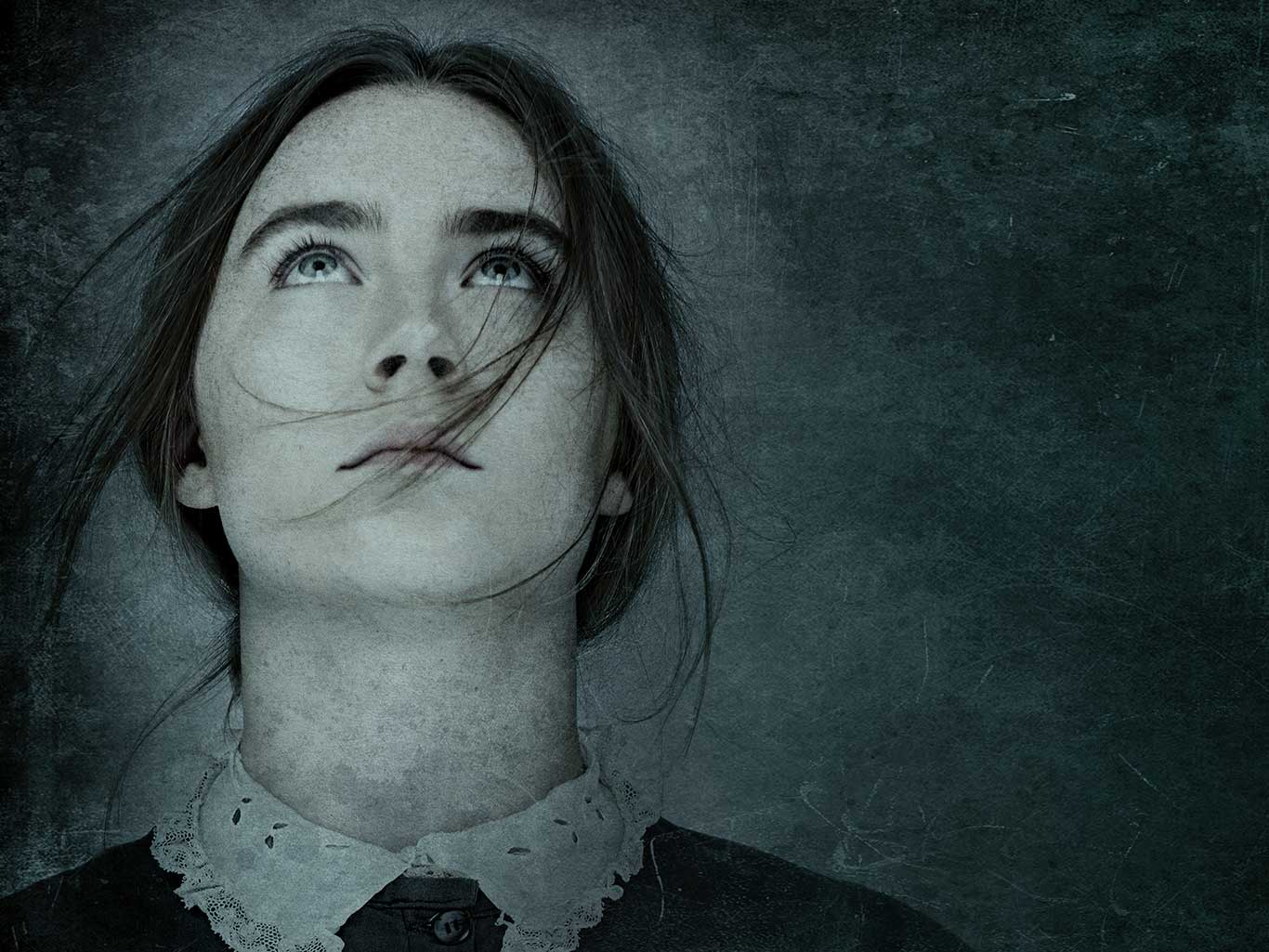After seeing Ivo Van Hove's fast paced, streamlined revival of A View From the Bridge, I was so intrigued to see what he would do with Arthur Miller's most famous play, The Crucible. Unfortunately, I left the Walter Kerr theatre with more questions than answers. They were not robust, existential questions about life's truths or human nature. These were literal questions about directorial intent. What time period are we in? Why is the pacing so laborious? Why is that chalkboard still on stage? Who is using those desks?
The opening scene is a classroom full of young girls in a classroom staring at a chalkboard. The color scheme is dull and gray. This moment is but a glimpse as the curtain quickly falls and rises again on a drastically different scene. This glimpse motif repeats itself throughout both acts and is the one shred of urgency in the entire production. The rest of the piece drags like a funeral dirge. I won't bore you with a summary as we all know the plot, but I'd be lying if I didn't tell you that I checked my watch more than I ever have during a show. I did see the piece early in the preview period, so I will try to be kind and assume that the pace will quicken by opening, but this piece is built on drama and suspense, both of which need a sense of urgency to unfold.
Philip Glass provides the score which aims to create a mood of suspense and even anxiety. It is mostly effective in meeting this goal, though the relentless wall of sound does distract from the text at times. Jan Versweyveld nails the ominous feeling of the piece with the mysterious stark lighting that highlights the cold, gray feeling of the sets, which he also designed. The focal point of the set is a chalkboard which works in the classroom and court room, but feels out of place in the Proctor home. Ditto for the desks and chairs. Wojciech Dziedzic's costumes represent curious choices that tie back to Van Hove's unclear (or unclearly articulated) vision. It is so difficult to tell what time period we are in. The Salem Witch Trials took lace in the late 1600s and the costumes are much more modern. They are not present day either, but rather somewhere in between. A modernized production would've been a remarkably intriguing concept, given recent political discussions over feminism, religion, and government power, but the performances are clearly period. The dialect and diction transport the audience to the past, while clearly modern props like coffee carafes place us in the present. It is quite jarring as an audience member and it made it extremely difficult for me to immerse myself in the world of the performances because I didn't know when or where that world was. If this was Van Hove's intention, then I commend his vision, but unfortunately it was hard for me to invest.
Though Saoirse Ronan is selling the tickets, her performance is not the standout. There is nothing inherently likable about her Abigail, who is more of a devious instigator than a sympathetic victim. As far as the ensemble of young girls is concerned, Tavi Gevinson's portrayal of Mary Warren is much more memorable. She is a vulnerable young girl who is clearly confused about her allegiances and that internal struggle shows in her nuanced characterization. Ben Whishaw and Sophie Okonedo carry the emotional heft of the show as John and Elizabeth Proctor, respectively. They are a hard-working couple maligned by ghosts from their past. They are the ultimate tragic tale. Every attempt they make to prove their innocence pushes them further down the rabbit hole. They are faced with one of life's ultimate conundrums. Lies or truth? If they tell the truth that they have not engaged in witchcraft, they will be executed. If they lie and say they have engaged, their lives will be spared, but they will have to one day meet their maker knowing they've committed a grave sin. Whishaw plays out this question with such reckless abandon that I felt as if I was on his back as he desperately flailed about the stage in search of answers. His work is visceral, animalistic, and even maniacal as he seeks absolution. This final scene was the only moment in the show that truly gripped me emotionally. It left me asking myself how high of a price I would pay to tell the truth and clear my name. This is what I call a "Miller Moment" where the beauty and purity of the text were able to shine through, unencumbered by Ivo Van Hove's confusing direction. I left the theatre largely disappointed, expecting the brilliance of A View from the Bridge to repeat itself, but this new-concept Crucible lacked clarity and cohesion.
The opening scene is a classroom full of young girls in a classroom staring at a chalkboard. The color scheme is dull and gray. This moment is but a glimpse as the curtain quickly falls and rises again on a drastically different scene. This glimpse motif repeats itself throughout both acts and is the one shred of urgency in the entire production. The rest of the piece drags like a funeral dirge. I won't bore you with a summary as we all know the plot, but I'd be lying if I didn't tell you that I checked my watch more than I ever have during a show. I did see the piece early in the preview period, so I will try to be kind and assume that the pace will quicken by opening, but this piece is built on drama and suspense, both of which need a sense of urgency to unfold.
Philip Glass provides the score which aims to create a mood of suspense and even anxiety. It is mostly effective in meeting this goal, though the relentless wall of sound does distract from the text at times. Jan Versweyveld nails the ominous feeling of the piece with the mysterious stark lighting that highlights the cold, gray feeling of the sets, which he also designed. The focal point of the set is a chalkboard which works in the classroom and court room, but feels out of place in the Proctor home. Ditto for the desks and chairs. Wojciech Dziedzic's costumes represent curious choices that tie back to Van Hove's unclear (or unclearly articulated) vision. It is so difficult to tell what time period we are in. The Salem Witch Trials took lace in the late 1600s and the costumes are much more modern. They are not present day either, but rather somewhere in between. A modernized production would've been a remarkably intriguing concept, given recent political discussions over feminism, religion, and government power, but the performances are clearly period. The dialect and diction transport the audience to the past, while clearly modern props like coffee carafes place us in the present. It is quite jarring as an audience member and it made it extremely difficult for me to immerse myself in the world of the performances because I didn't know when or where that world was. If this was Van Hove's intention, then I commend his vision, but unfortunately it was hard for me to invest.
Though Saoirse Ronan is selling the tickets, her performance is not the standout. There is nothing inherently likable about her Abigail, who is more of a devious instigator than a sympathetic victim. As far as the ensemble of young girls is concerned, Tavi Gevinson's portrayal of Mary Warren is much more memorable. She is a vulnerable young girl who is clearly confused about her allegiances and that internal struggle shows in her nuanced characterization. Ben Whishaw and Sophie Okonedo carry the emotional heft of the show as John and Elizabeth Proctor, respectively. They are a hard-working couple maligned by ghosts from their past. They are the ultimate tragic tale. Every attempt they make to prove their innocence pushes them further down the rabbit hole. They are faced with one of life's ultimate conundrums. Lies or truth? If they tell the truth that they have not engaged in witchcraft, they will be executed. If they lie and say they have engaged, their lives will be spared, but they will have to one day meet their maker knowing they've committed a grave sin. Whishaw plays out this question with such reckless abandon that I felt as if I was on his back as he desperately flailed about the stage in search of answers. His work is visceral, animalistic, and even maniacal as he seeks absolution. This final scene was the only moment in the show that truly gripped me emotionally. It left me asking myself how high of a price I would pay to tell the truth and clear my name. This is what I call a "Miller Moment" where the beauty and purity of the text were able to shine through, unencumbered by Ivo Van Hove's confusing direction. I left the theatre largely disappointed, expecting the brilliance of A View from the Bridge to repeat itself, but this new-concept Crucible lacked clarity and cohesion.




